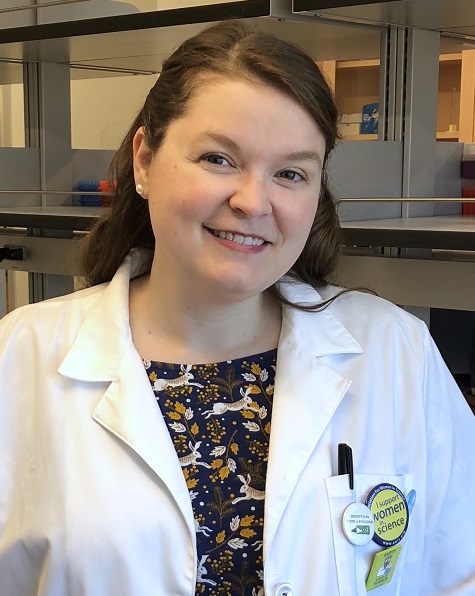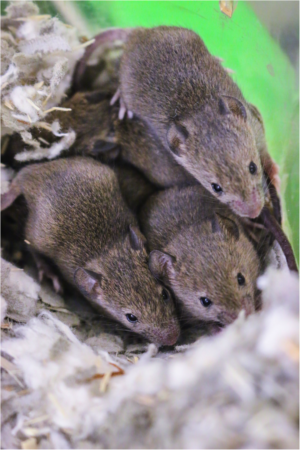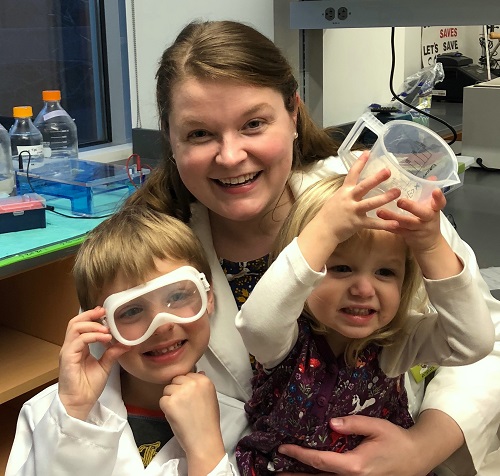 Dr. Megan Phifer-Rixey
Dr. Megan Phifer-Rixey
Assistant Professor
Biology Department
Monmouth University
phiferrixeylab.com
Start Date: Fall 2016
PhD: University of Pennsylvania; mentored by Dr. Paul S. Schmidt
Postdoc: University of Arizona and the University of California, Berkeley, both with Dr. Michael W. Nachman
About Monmouth University:
Monmouth University is a primarily undergraduate institution located on the Jersey Shore. We are known for our polling institute, enthusiastic basketball fans, and our lovely campus that includes the mansion from the movie Annie. I am an Assistant Professor in the Biology Department. Our faculty are active in a variety of research areas, including a growing Marine and Environmental Biology Program. One of our biggest strengths is our emphasis on meaningful research experiences for undergraduates.
About the research program:
In the broadest sense, my research program addresses questions about evolution in wild populations, ranging from population genetics to speciation. Right now, my lab’s main focus is on the genetics of adaptation and, in particular, understanding how wild house mice have successfully adapted to diverse environments worldwide. Our research is integrative—bringing together field work, bench work, phenotyping, bioinformatics, and computational approaches. Of course, we are located right on the Jersey Shore, so we are starting new projects using population genetics and genomics to answer questions about ecologically important regional fisheries.
What has been the biggest challenge as a new PI so far?
Without any doubt, the biggest challenge is time. As a new PI, you are essentially running a business—managing a budget, applying for grants, directing a lab, etc., while also teaching and mentoring. Somewhere in there, you have to make space to write and be creative. All of this is happening while you are (generally) in a brand new place and working to expand your professional network and your personal support network. I spend a lot of time on Skype! The good news is that you become at peace with the struggle. It is simply not possible to move everything along quickly, so you have to prioritize and learn to say no. When I was a grad student, I worried I would not have enough clever ideas to be a PI. Now I realize the bigger challenge is to pick and choose wisely and to carve out the time needed to pursue those ideas.
What has been the biggest surprise so far about being a new PI?
I was surprised by how much and how quickly I became invested in the success of my students. I expected to develop strong relationships with my research students, but at a small university like Monmouth, you also get to know the students in your classes. When they are succeeding, you feel amazing, and when they are stumbling, you find yourself working hard to figure out ways to reach them.
Do you have a funny story to share from an Evolution Meeting?
This is not so much funny as it is representative of how friendly the meetings are. In the summer of 2012, I was on a three-month trek to collect wild house mice with my son, who was about 16 months old, and my husband. That year, the meeting was in Ottawa, and it was a Joint Congress, so we decided to take a break from collecting in Vermont and drive to Ottawa. We had fun crossing the border with all of my odd supplies, but we made it to the meeting on time. We arrived at the hotel to a very crowded lobby. While my husband wrangled our stuff, I got in line with my not very happy son who immediately started letting everyone know how he felt. The person ahead of us in line turned around and started chatting with us, offering to let us go ahead. My son calmed down and we had a nice conversation. Jonathan Losos did not know me, but he was very kind that day. My children now regularly go to meetings with me, but that was the first meeting I attended with my son, and it meant a lot that he was welcomed. It has been heartening to see how much effort SSE has made to make the annual meetings family-friendly.
When was your first Evolution Meeting, and how did it affect your career?
My first Evolution meeting was in 2006 at Stony Brook University. At the time, I was in the thick of my field season investigating shell color variation in Littorina obtusata (flat periwinkles) throughout the Gulf of Maine. I was spending weeks alternating between collecting snails at crazy hours and running experiments at crazy hours. In my memory, it feels like I showed up, showered, and then gave a talk.
One of the special things about the Evolution Meeting is how welcoming it is to students. I gave a talk and people came! The question and answer portion was lively, and trainees and PIs came up to me after to discuss my work. I met many people in my field for the first time at that meeting. Importantly, I started to see myself as part of that field. Now, I am looking forward to bringing my own students to the meetings.
Besides research, how do you promote science?
I have an amazing lab of undergraduates. Last summer, one of them put together a proposal to bring a DNA extraction workshop to local elementary schools. His proposal was successful, and we are now funded by the European Society for Evolutionary Biology (ESEB). We piloted the project last semester and, with the help of another undergraduate, we will be working with >150 students this semester.
The lab has come together to run this project and we now plan to do a new project every year, with different lab members taking the lead, emphasizing different aspects of evolution. Funding for outreach programs is limited, and the investments that SSE and ESEB make are absolutely critical. Because we have funding, we can provide supply kits to each classroom, and the lab can be run in the future without our help. These programs are low cost, but have a big impact.
Do you teach evolution? What is the hardest concept to teach?
I teach Evolution both as a standalone course and as part of our Introductory Biology sequence. I think the mathematical framework for understanding evolutionary processes is elegant and comforting. With a little probability and statistics, we can start to understand the balance between mutation, selection, and drift and make sense of messy reality. My students, however, do not agree on the “comforting” part. We work through it, though, and I have gotten some good advice from colleagues on how to integrate quantitative skills into the courses.
Do you have a time management tip to share?
I aggressively calendar everything. This helps me plan my time, but it is really more of a mental tool to help me compartmentalize, effectively switch from one task to another. This strategy works best when you are realistic about the time that tasks will take. I also recommend scheduling time to read and to just think. Don’t necessarily wait for vast unbroken time (which never appears). Papers can be read in an hour, but do try and schedule some big blocks of time.
What one piece of advice would you give to a postdoc?
You can do it! You are already doing it. Value your contributions and your ideas. While you may be overwhelmed with data, writing, and applying for jobs, invest in yourself and take the time to develop your own research program for the future.
 Dr. Megan Phifer-Rixey
Dr. Megan Phifer-Rixey
